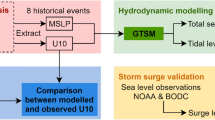Abstract
A review of progress over the past 50 years in observing and forecasting of tropical cyclones is presented. Tremendous progress has been made in track forecasting in the past 20 years with the improvement in numerical model guidance and the use of consensus forecasting, and this has contributed to a number of warning centers now issuing five-day track forecasts that are as accurate as three-day forecasts of a decade ago. Techniques are now available to specify the track forecast uncertainty for assessing the risk of a tropical cyclone. With the advent of five-day forecasts, a focus on improved understanding of formation has led to two field experiments. A recent advance has been in extended-range (5–30 days) forecasts of tropical cyclone events (formations and tracks) in the western North Pacific from the ECMWF 32-day ensemble predictions. This advance is a contribution to a goal of seamless forecasting from one day to a season for tropical cyclones. Little progress has been made in intensity forecasting, although the Hurricane Forecast Improvement Project in the United States and recent field experiments may offer some future advances. Some advances in forecasting tropical cyclone impacts such as storm surge, surface waves, and precipitation have been achieved. Future opportunities for continued advances are possible such that improved warnings can lead to reductions in losses of lives and minimizing damages from tropical cyclones.
Similar content being viewed by others
References
Bell, M. M., and M. T. Montgomery, 2010: Sheared deep vertical convection in pre-depression Hagupit during TCS-08. Geophys. Res. Lett., 37, L06802, doi:10.1029/2009GL042313.
Chou, K.-H., C.-C. Wu, P.-H. Lin, S. D. Aberson, M. Weissman, F. Harnisch, and T. Nakazawa, 2011: The impact of dropwindsondes on typhoon track forecasts in DOTSTAR and T-PARC. Mon. Wea. Rev., 139, 1728–1743.
DeMaria, M., J. A. Knaff, R. Knabb, C. Lauer, C. R. Sampson, and R. T. DeMaria, 2009: A new method for estimating tropical wind speed probabilities. Wea. Forecasting, 24, 1573–1591.
—, —, C. R. Sampson, J. A. Knaff, and K. D. Musgrave, 2013: Is tropical cyclone intensity guidance improving? Bull. Amer. Meteor. Soc., (submitted).
Dube, S. K., T. S. Murty, J. C. Feyen, R. Cabrerra, B. A. Harper, J. D. Bales, and S. Amer, 2010: Storm surge modeling and applications in coastal areas. Chap. 12, Global Perspectives in Tropical Cyclones, J. C. L. Chan and J. D. Kepert, Eds., World Scientific Publishing Company, pp. 363–408.
Elsberry, R. L., 1990: International experiments to study tropical cyclones in the western North Pacific. Bull. Amer. Meteor. Soc., 71, 1305–1316.
—, —, 2007: Advances in tropical cyclone motion prediction and recommendations for the future. Bull. World Meteor. Organiz., 56, 131–135.
—, —, W. M. Clune, G. Elliott, and P. A. Harr, 2009: Evaluation of global model early track and formation predictions during the combined TCS-08 and T-PARC field experiment. Asia-pac. J. Atmos. Sci., 45, 357–374.
—, —, M. S. Jordan, and F. Vitart, 2010: Predictability of tropical cyclone events on intraseasonal timescales with the ECMWF monthly forecast model. Asia-pac. J. Atmos. Sci., 46, 135–153.
—, —, and —, 2011: Evaluation of the ECMWF 32-day ensemble predictions during 2009 season of western North Pacific tropical cyclone events on intraseasonal timescales. Asia-pac. J. Atmos. Sci., 47, 305–318.
Fiorino, M., and R. L. Elsberry, 1989: Some aspects of vortex structure related to tropical cyclone motion. J. Atmos. Sci., 46, 975–990.
Frank, W. M., and P. E. Roundy, 2006: The role of tropical waves in tropical cyclogenesis. Mon. Wea. Rev., 134, 2397–2417.
Goerss, J. S., 2007: Prediction of consensus tropical cyclone track forecast error. Mon. Wea. Rev., 135, 1985–1993.
—, —, C. R. Sampson, and J. M. Goerss, 2004: A history of western North Pacific tropical cyclone track forecast skill. Wea. Forecasting, 19, 633–638.
Hansen, J. A., J. S. Goerss, and C. Sampson, 2011: GPCE-AX: An anisotropic extension to the Goerss predicted consensus error in tropical cyclone track forecasts. Wea. Forecasting, 26, 416–422.
Hasegawa, H., N. Kohno, and H. Hayashibara, 2012: JMA’s storm surge prediction for WMO Storm Surge Watch Scheme (SSWS). RSMC Tokyo Typhoon Center Technical Review No. 14, 12 pp.
Montgomery, M. T., and Coauthors, 2012: The Pre-Depression Investigation of Cloud-systems in the Tropics (PREDICT) experiment. Bull. Amer. Meteor. Soc., 93, 153–172.
Nagata, K., 2011: Quantitative Precipitation Estimation and Quantitative Precipitation Forecasting by the Japan Meteorological Agency. RSMC Tokyo-Typhoon Center Technical Review, No. 13, 37–50.
Sampson, C. R., P. A. Wittman, E. A. Serra, H. T. Tolman, J. Schauer, and T. Marchok, 2013: Evaluation of wave forecasts consistent with tropical cyclone warning center wind forecasts. Wea. Forecasting, (in press).
Shay, L. K., 2010: Air-sea interactions in tropical cyclones. Chap. 3, Global Perspectives in Tropical Cyclones, J. C. L. Chan and J. D. Kepert, Eds., World Scientific Publishing Company, pp. 93–132.
Tsai, H.-C., and R. L. Elsberry, 2013: Opportunities and challenges for extended-range predictions of tropical cyclone impacts on hydrological predictions. J. Hydrology, dx.doi.org/10.1016/j.hydrol.2012.12.025.
—, —, and M. S. Jordan, 2013: Objective verifications and false alarm analyses of western North Pacific tropical cyclone event forecasts by the ECMWF 32-day ensemble. Asia-pac. J. Atmos. Sci., 49, doi: 10.1007/s13143-013-0038-6.
Vitart, F., F. Prates, A. Bonet, and C. Sahin, 2012a: New tropical cyclone products on the web. ECMWF Newsletter, No. 130, 17–23.
—, —, A. Robertson, and D. Anderson, 2012b: Subseasonal to seasonal prediction project: Bridging the gap between weather and climate. Bull. Amer. Meteor. Organiz., 61, 23–28.
Author information
Authors and Affiliations
Corresponding author
Rights and permissions
About this article
Cite this article
Elsberry, R.L. Advances in research and forecasting of tropical cyclones from 1963–2013. Asia-Pacific J Atmos Sci 50, 3–16 (2014). https://doi.org/10.1007/s13143-014-0001-1
Received:
Accepted:
Published:
Issue Date:
DOI: https://doi.org/10.1007/s13143-014-0001-1




